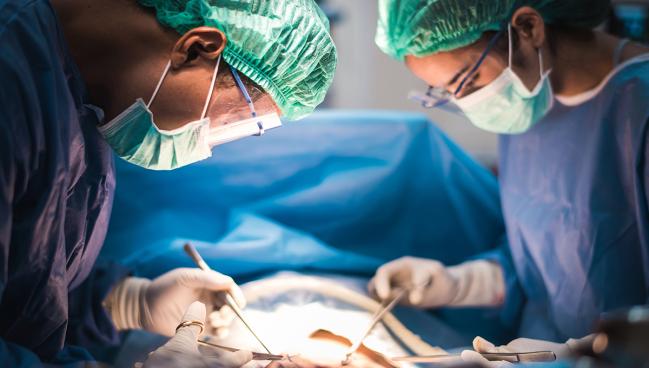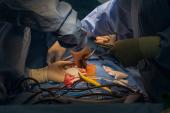CAD From Donor Hearts Warrants Follow-Up, Vigilant Risk Factor Control
The biggest unknown is whether this would increase the likelihood of more allograft vasculopathy down the line.

Donor-transmitted coronary artery disease (TCAD) following heart transplantation may occur in as many as one in five patients but does not seem to affect survival in those who are well enough to undergo angiography within the first 3 months post-transplant, according to new data. However, there was a signal of more adverse cardiovascular outcomes in recipients found to have significant TCAD.
Since most heart donors are healthy, young individuals, the likelihood of them having, and passing on, CAD has been thought to be minimal, and most centers don’t routinely perform angiography pretransplant. However, the ongoing need for new sources of potential organs for donation—including those from donors with circulatory death (DCD)—is driving physicians to consider hearts that might have been rejected previously.
“Our study provides some evidence regarding questions like, if we do not have the possibility to perform a coronary artery disease angiogram, should we discard these donors? And the answer is probably not,” lead author David Couto-Mallón, MD (Hospital Universitario de A Coruña, Spain), told TCTMD.
Rushi Parikh, MD (University of California, Los Angeles), who was not involved in the study, agreed. “These data that the authors present suggest that using some of these higher-risk donors and donors with transmitted CAD is reasonable, but obviously the signal toward increased cardiovascular mortality and MACE requires further investigation and we have to be a little cautionary,” Parikh said.
The study was published recently in the Journal of the American College of Cardiology.
TCAD Not Tied to Mortality
For the DONOR-CAD study, Couto-Mallón and colleagues included 1,918 patients who underwent heart transplant at one of 11 Spanish centers between 2008 and 2018. Of the 937 who had post-transplant coronary angiography within 3 months (mean age 54.1 years; 75.5% men), TCAD was observed in 18.3%, with 6.9% having significant disease, defined as any stenosis ≥ 50% in the epicardial coronary arteries. Pretransplant angiography, by contrast, was performed in only 0.4% of patients.
While the authors did not find an association between significant TCAD and all-cause mortality over a median follow-up period of 6.3 years (adjusted HR 1.44; 95% CI 0.89-2.35), TCAD was an independent predictor of both cardiovascular mortality (adjusted HR 2.25; 95% CI 1.20-4.19) and the combination of cardiovascular death or nonfatal MACE (adjusted HR 2.42; 95% CI 1.52-3.85).
There seemed to be no impact of nonsignificant TCAD on clinical outcomes.
Notably, donors of hearts with significant TCAD were older and more likely to be male, to have died from cerebrovascular causes, and to have a history of smoking and diabetes.
Because of the higher cardiovascular risk found in those with significant TCAD, Couto-Mallón said the results indicate that “we have to be more aggressive in the treatment of cardiovascular risk factors in these recipients.”
But overall, the findings “support the possibility of using older donors [and] other DCD donors without coronary angiogram,” he continued.
Increased Risk of CAV?
An open question is whether those who develop TCAD will be at higher risk of cardiac allograft vasculopathy (CAV) down the line.
“This is important because recipients that receive the organs with coronary artery disease probably would benefit [from] another strategy of immunosuppression, like mTOR inhibitor,” Couto-Mallón said.
Parikh agreed that this is perhaps the most important unknown in this space. “CAV is regarded as the Achilles heel of contemporary heart transplantation,” he said. “Understanding the relationship between this donor-transmitted disease and the development of accelerated CAV is going to be critical and will shape and possibly lead to personal post-transplant surveillance and tailoring immunosuppressive therapy to patients at higher risk, and hopefully . . . attenuate their cardiovascular risk.”
For example, he suggested possibly performing more frequent angiography on these recipients or offering them more intense immunosuppressive therapy. “We still need more data for that,” Parikh said. “Doing a study like this and looking at the relationship between baseline or donor-transmitted disease and then CAV down the line, which is diagnosed using IVUS, will tie that mechanism together. If that relationship is shown, then these are patients who are at higher risk and we can personalize their therapy.”
The good news for now is that “the data don't suggest that we have to turn away these donors,” Parikh continued. “A lot of times, we don't know that these donors have coronary disease until they've already been transplanted, for a variety of reasons.”
Donor angiograms are often only obtained if a patient has risk factors and aren’t always even possible in the event of DCD hearts, he added.
In an accompanying editorial, Richard Cheng, MD (University of California–San Francisco), and colleagues agree that “consideration should be given to more frequent ischemic evaluation and surveillance coronary angiography in patients who received a donor heart without a donor angiogram and/or of older age.”
They also say future research is warranted to determine whether PCI mitigates the risk of TCAD.
Yael L. Maxwell is Senior Medical Journalist for TCTMD and Section Editor of TCTMD's Fellows Forum. She served as the inaugural…
Read Full BioSources
Couto-Mallón D, Almenar-Bonet L, Barge-Caballero E, et al. Prevalence, characteristics, and prognostic relevance of donor-transmitted coronary artery disease in heart transplant recipients. J Am Coll Cardiol. 2023;82:753-767.
Cheng R, Azarbal B, Smith J. Donor-transmitted coronary artery disease: another avenue to expand heart transplantation? J Am Coll Cardiol. 2023;82:768-770.
Disclosures
- Couto-Mallón reports receiving a research grant from the Fundación Mutua Madrileña, which supplied funding for the present study. This research project was co-financed with European Union Regional Development Funds, supplied through the Centro de Investigación Biomédica en Red de Enfermedades Cardiovasculares, Instituto de Salud, Carlos III, Spanish Ministry of Economy and Competitiveness.
- Cheng and Parikh report no relevant conflicts of interest.





Comments